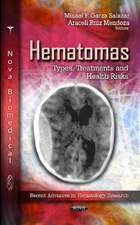Antiphospholipid Antibody Syndrome: From Bench to Bedside: Rare Diseases of the Immune System
Editat de Pier Luigi Meronien Limba Engleză Hardback – 3 dec 2014
| Toate formatele și edițiile | Preț | Express |
|---|---|---|
| Paperback (1) | 841.00 lei 6-8 săpt. | |
| Springer International Publishing – 23 aug 2016 | 841.00 lei 6-8 săpt. | |
| Hardback (1) | 721.77 lei 6-8 săpt. | |
| Springer International Publishing – 3 dec 2014 | 721.77 lei 6-8 săpt. |
Preț: 721.77 lei
Preț vechi: 759.76 lei
-5% Nou
138.12€ • 145.23$ • 114.12£
Carte tipărită la comandă
Livrare economică 17 aprilie-01 mai
Specificații
ISBN-10: 3319110438
Pagini: 267
Ilustrații: X, 267 p. 19 illus., 15 illus. in color.
Dimensiuni: 155 x 235 x 17 mm
Greutate: 0.57 kg
Ediția:2015
Editura: Springer International Publishing
Colecția Springer
Seria Rare Diseases of the Immune System
Locul publicării:Cham, Switzerland
Public țintă
Professional/practitionerCuprins
Foreword.- Preface.- 1 APS: Introductory notes.- 2 Immunology and Genetics of APS.- 3 The paradox of the lupus anticoagulant.- 4 The pathogenic mechanism(s) for APS-mediated thrombosis.- 5 The pathogenic mechanism(s) for APS-mediated pregnancy loss.- 6 Classification criteria.- 7 Non-classification criteria.- 8 Obstetric APS.- 9 APS and the nervous system.- 10 APS and renal involvement.- 11 Non-thrombotic hematologic manifestations in APS.- 12 Heart and APS.- 13 Skin and APS.- 14 Additional organs involved in APS (eye, ENT, GI, endocrine).- 15 Treatment of thrombosis.- 16 Treatment of pregnancy complications.- 17 Asymptomatic carries of APS.- 18 New treatments.- 19 Secondary APS.- 20 Catastrophic APS.
Recenzii
“The purpose is to provide an overview of this very difficult subject that will benefit bench researchers as well as bedside clinicians. The book would serve any audience who wants to know more about antiphospholipid syndrome. … This is an excellent, up-to-date overview of antiphospholipid syndrome. It will serve as a handy tool to get more information on the topic.” (Dany V. Thekkemuriyil, Doody’s Book Reviews, February, 2015)
Textul de pe ultima copertă
This book, part of the series Rare Diseases of the Immune System, offers comprehensive, up-to-date coverage of the pathophysiology and management of the antiphospholipid syndrome (APS). Immunologic and genetic aspects are discussed and the pathogenic mechanisms responsible for such phenomena as APS-mediated thrombosis and pregnancy loss or complications are explained. The main clinical manifestations and classification criteria are described and diagnostic tools, identified. Close attention is paid to the nature of the involvement of other organs or organ systems in APS, including the nervous, endocrine, hematologic, cardiovascular, and gastrointestinal systems, the kidney, the skin, and the eye. Specific chapters describe the treatment of the different symptoms, the preventive therapies of value in avoiding recurrences, and innovative treatment approaches. The authors are senior experts in the field who are aided by younger fellows, ensuring that the book is also educationally oriented. This handy volume will be a valuable tool for postgraduates in training and professionals wishing to extend their knowledge of this specific syndrome
Caracteristici
Presents and discusses innovative treatments in addition to standard treatment options
Describes the involvement of other organs or organ systems
Descriere
This book, part of the series Rare Diseases of the Immune System, offers comprehensive, up-to-date coverage of the pathophysiology and management of the antiphospholipid syndrome (APS). Immunologic and genetic aspects are discussed and the pathogenic mechanisms responsible for such phenomena as APS-mediated thrombosis and pregnancy loss/complications are explained. The main clinical manifestations, classification criteria and diagnostic tools are identified, and close attention is paid to the nature of the involvement of various organs or organ systems in APS. Specific chapters describe the treatment of the different symptoms, therapies of value in avoiding recurrences, and innovative treatment approaches. The authors are senior experts in the field who are aided by younger fellows, ensuring that the book is also educationally oriented. This handy volume will be a valuable tool for postgraduates in training and professionals wishing to extend their knowledge of this specific syndrome.















